Speculative Faith Reading Group 9: From Defeat, Final Victory
This very morning I re-read the end of The Lion, the Witch and the Wardrobe, and wept joyously like a child. It’s embarrassing, perhaps, but if so I could stand more of this sense.
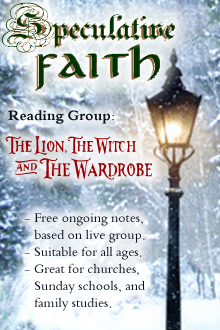 As you’ll see in these final reading-group questions, this classic story’s finale includes what J.R.R. Tolkien called a “eucatastrophe.” This is the opposite of “catastrophe,” he said; in that a catastrophe brings sudden terrible horror out of goodness, but eucatastrophe brings, out of horror and defeat, great victory and eternal joy. Tolkien, of course, was a friend of Narnia author C.S. Lewis, and the two shared very Biblical and very truthful views of this concept.
As you’ll see in these final reading-group questions, this classic story’s finale includes what J.R.R. Tolkien called a “eucatastrophe.” This is the opposite of “catastrophe,” he said; in that a catastrophe brings sudden terrible horror out of goodness, but eucatastrophe brings, out of horror and defeat, great victory and eternal joy. Tolkien, of course, was a friend of Narnia author C.S. Lewis, and the two shared very Biblical and very truthful views of this concept.
I coined the word ‘eucatastrophe’: the sudden happy turn in a story which pierces you with a joy that brings tears (which I argued it is the highest function of fairy-stories to produce). And I was there led to the view that it produces its peculiar effect because it is a sudden glimpse of Truth, your whole nature chained in material cause and effect, the chain of death, feels a sudden relief as if a major limb out of joint had suddenly snapped back. It perceives – if the story has literary ‘truth’ on the second plane (….) – that this is indeed how things really do work in the Great World for which our nature is made. And I concluded by saying that the Resurrection was the greatest ‘eucatastrophe’ possible in the greatest Fairy Story – and produces that essential emotion: Christian joy which produces tears because it is qualitatively so like sorrow, because it comes from those places where Joy and Sorrow are at one, reconciled, as selfishness and altruism are lost in Love.
— Letter 89, from The Letters of J.R.R. Tolkien (quoted at TolkienGateway.net)
 Even among the greatest stories, even among The Chronicles of Narnia, the finale of LWW is unique. Here are echoes of Resurrection, both of Aslan and of the Witch’s victims. Here is justice, then final victory, and celebration and feasting and joy. Yet here also is an echo of clear Godly truth: that at the end of this victory, Christ’s people will reign physically, over a physical kingdom, having been personally appointed by Him to reflect His glory in this way.
Even among the greatest stories, even among The Chronicles of Narnia, the finale of LWW is unique. Here are echoes of Resurrection, both of Aslan and of the Witch’s victims. Here is justice, then final victory, and celebration and feasting and joy. Yet here also is an echo of clear Godly truth: that at the end of this victory, Christ’s people will reign physically, over a physical kingdom, having been personally appointed by Him to reflect His glory in this way.
This first Narnia story not only “repeats” these truths, stating them directly or by parallel. It shows them. In the author’s descriptions, his glorying in “cutting loose” and letting great evil be overcome by greater good, and in his wonder of the victory and sights and sounds and scents, we sense this same victory will come to our world. We don’t merely believe it with our heads; we feel it with our hearts. And our desire increases.
Thus we don’t simply read stories like this one to “escape,” or to remind ourselves of Biblical truths in memorable ways. Instead we read them to feel God’s truths, to keep fighting, and to long for the New Heavens and New Earth.
Chapter 15: Deeper Magic from Before the Dawn of Time
- I hope no one who reads this book has been quite as miserable as Susan and Lucy were that night; but if you have been—if you’ve been up all night and cried till you have no more tears left in you—you will know that there comes in the end a sort of quietness. You feel as if nothing was ever going to happen again. (page 158) Is that true of you? If so, do you notice how well this helps us “connect” to the story and characters? What thinking might you guess the author needed to do, to make such observations and connections?
- The sky in the east was whitish by now and the stars were getting fainter—all except one very big one low down on the eastern horizon. (page 160) In our world, what star would that be? Why might it be significant? What name and mythology is associated with it?
 The Chronicles of Narnia are not direct allegory, but a “supposal.” As we’ve seen, that means it contains allegorical elements, but is not all allegory; Narnian “rules” will be similar to those of our world, yet different. With that in mind, it seems Aslan’s death, and some signs associated with it, echo Christ’s death and signs. So what do you think of the sun’s rising? The Stone Table cracking? Aslan’s body gone and the girls’ reactions?
The Chronicles of Narnia are not direct allegory, but a “supposal.” As we’ve seen, that means it contains allegorical elements, but is not all allegory; Narnian “rules” will be similar to those of our world, yet different. With that in mind, it seems Aslan’s death, and some signs associated with it, echo Christ’s death and signs. So what do you think of the sun’s rising? The Stone Table cracking? Aslan’s body gone and the girls’ reactions?- Aslan is raised by “more magic” (page 162). Christ was raised miraculously. Are they different? Is “magic” according to story-world “rules” similar to “miracles” in our world?
- Similarly, what is similar between the Deeper Magic and our world’s “magical” rules according to the Creator? Does it sound like the Deeper Magic would work every time it’s tried, or was established only for Aslan’s death? (Hint: the Stone Table’s sign.)
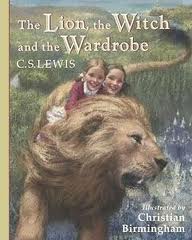 How do you feel reading about the romp, Aslan’s mighty roar, and the ride on his back?
How do you feel reading about the romp, Aslan’s mighty roar, and the ride on his back?
Chapter 16: What Happened About the Statues
- Aslan brings the stone statues to life. What Biblical truth seems to have inspired this?
- Answer: This is like resurrection, yet different in some ways. For example, Jesus raised people such as Lazarus to life, yet at some point Lazarus died again. Similarly, we can assume these creatures, such as Mr. Tumnus, will still die at some point. (Consider reading 1 Cor. 15: 35-58, and the whole chapter. This describes the future and final resurrection of God’s people to have spiritual [perfected] physical bodies as He does.)
- About that other talking lion — no other talking lions are mentioned throughout the series. Could it be significant that Aslan first “resurrects” a creature much like himself?
- Here with the Giant, we find out what it was like to have been turned into stone. Just like falling asleep and remembering nothing, the Giant implies (page 169). How is this similar to the “sting” of physical death in our world (1 Cor. 15:55)? How is it different?
- “If the Witch is to be finally defeated before bedtime we must find the battle at once.” (Aslan speaking, page 174) “Before bedtime,” he says. What seems clear from this?
- Soon all the dogs and lions and wolves … (page 175). Look! Good wolves in Narnia?
- Favorite creatures? Lions? Centaurs? Dogs? Satyrs? Dwarfs? Tree-girls? The Giant?
- What “music” do you hear while reading this scene, with resurrected creatures and shouts and celebration? What longings do these reinforce? How do these glorify God?
- What “music” do you hear at the final battle? What anticipation does this scene arouse?
Chapter 17: The Hunting of the White Stag
- In all this celebration, with certain victory (see Aslan’s “bedtime” statement earlier!) now realized with the battle’s end, why this moment to correct Lucy (page 179)?
- [Edmund was] not only healed of his wounds but looking better than [Lucy] had seen him look—oh, for ages; in fact ever since his first term at that horrid school which was where he had begun to go wrong. He had become his real old self again and could look you in the face. (page 180) Here, another factor for Edmund’s evil is said for the first time. Why might it be said here near the story’s end? Does this help explain or excuse Edmund?
- Do you believe Edmund ever learns what Aslan did for him? Why not tell him now?
- And oh, the cry of the seagulls! Have you heard it? Can you remember? (page 181). We have never been to Narnia, and (we might guess) Lewis never has, either. Yet he speaks of it this way. How does this also make us dream and long for such a place or a world?
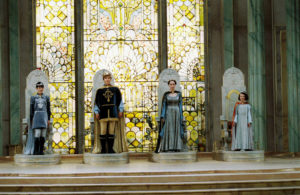 At last, Aslan crowns the four children kings and queens, and fulfills the prophecy. This is a famous ending of many fairy tales. Yet from which “fairy tale,” that is true Story, does this idea arise? Here’s a hint from author Randy Alcorn: “God never gave up His plan for us OR for earth. Romans 8 alone, even if we didn’t have countless other passages in the prophets and gospels and epistles, is emphatic on the fact that Christ’s redemptive work and the resurrection is not limited to us, but extends to the rest of His creation, which groans for the coming deliverance. As resurrected beings we will reign over a resurrected earth (with animals, culture, water, trees, fruit, buildings, etc.) with our resurrected Christ and each other for all eternity. As his stewards, and kings and queens under the King of Kings, we’ll never exhaust the wonders of a universe created by an infinitely fascinating God. And certainly we’ll never run out of things to do!”
At last, Aslan crowns the four children kings and queens, and fulfills the prophecy. This is a famous ending of many fairy tales. Yet from which “fairy tale,” that is true Story, does this idea arise? Here’s a hint from author Randy Alcorn: “God never gave up His plan for us OR for earth. Romans 8 alone, even if we didn’t have countless other passages in the prophets and gospels and epistles, is emphatic on the fact that Christ’s redemptive work and the resurrection is not limited to us, but extends to the rest of His creation, which groans for the coming deliverance. As resurrected beings we will reign over a resurrected earth (with animals, culture, water, trees, fruit, buildings, etc.) with our resurrected Christ and each other for all eternity. As his stewards, and kings and queens under the King of Kings, we’ll never exhaust the wonders of a universe created by an infinitely fascinating God. And certainly we’ll never run out of things to do!”- But amid all these rejoicings, Aslan himself quietly slipped away. (page 182) Why does he leave like this, without bidding goodbye or prophesying his next arrival? If you have read the rest of the Chronicles, compare this with the end of The Last Battle. Might it be a reminder that as wonderful as this story is, other battles and stories are yet to come? Might it remind us also that the absolute final victory-over-all-victories is still future?
- Mr. Beaver first says the famous words: “He’s wild, you know. Not like a tame lion.” (page 182) We’ve already seen Aslan show this (and we even saw him, for the first and last time, contrasted with a Narnian talking “tame lion”). How does this reflect Christ?
- Read the description of how the children as Kings and Queens ruled Narnia: … and generally stopped busybodies and interferers and encouraged ordinary people who wanted to live and let live (page 183). How does this reflect our longing for good King-appointed leadership in the world? How might this be especially poignant at elections?
- What is the White Stag? How does he figure in Celtic mythology, and even Christian medieval mythology? “In Celtic traditions, white stags represent messengers from the afterlife. Arthurian legend has it that the creature can never be caught — King Arthur’s pursuit of the animal represents mankind’s spiritual quest” (from a 2008 news article).
- Are you like me, when the Kings and Queens see the lamp-post and think they must go further? No! Don’t go or you’ll lose it all! Yet how does this “loss” strengthen the story and remind us that the greater story, both in Narnia and in reality, hasn’t yet ended?


































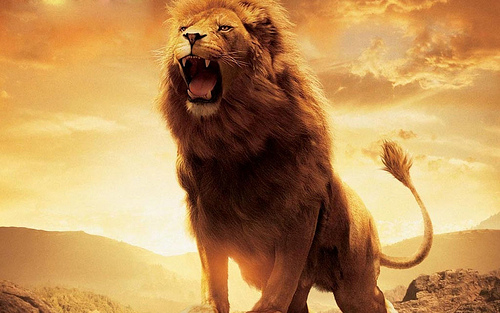

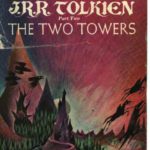
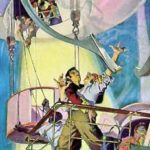




I think the fact that they do return reminds us that “all stories have an ending” and even our mountaintop experiences drop us back in the “real world.” I have issues with how Andrew Jackson portrayed the latter in his second film, but…
The Morning Star. If any mythological symbol has confused and convoluted meanings, it would be this, I think, because it can mean both the Devil and Christ. According to its Wikipedia article, the Greek name means “Light Bringer,” which describes Jesus well. It’s also the planet Venus, which I believe represents fertility and beauty; the connotation of fertility being related with the concept of spring, all of which is Resurrection imagery. It rises before the Sun, sort of like a herald coming before the full Light.
The cracking of the Table and the initial disappearance of Aslan’s body are probably direct homages to the real Gospel story — the tearing of the Veil and the displacement of Christ’s resurrected body without disturbing the graveclothes (proving that the body was not stolen).
It seems like Aslan rises just at the moment of sunrise. The sun is the greatest light we know, and I think it’s totally unsurprising that we associate Christ with the sun, even if pagans associated some of their gods with the sun as well. I think God must have known and ordained that we would interpret the cycle of night of day as a symbol of death and resurrection, of eternal hope.
I’m curious. Are there any theories out there as to when in the day the moment of Jesus’ resurrection actually took place? Could the true Resurrection also have occurred at the moment of dawn, thus validating our use of nature-symbolism?
Narnian magic and real-world miracles are similar in some ways but are not directly parallel. I think Narnian magic represents the divine ordering of the universe, when seen and perceived by finite beings. “Magic” works outside of Narnia, since it drew the children into the wardrobe. Since the Narnian mythos includes the concept of many worlds, I think “magic” must be something transcendent above all the worlds. I think real-world, supernatural miracles would indeed be “magic” by Narnian definition, but I think much of what we call science would also be Narnian magic, as well as many ordinary things like love or coincidence or fate.
Keeping in mind that the Narnian mythos includes multiple worlds, it seems clear that the Deeper Magic must be older than the world of Narnia itself, and thus not restricted to the world of Narnia. Coming from “Before the Dawn of Time,” the Deeper Magic must have been before all worlds. May it’s a property or attribute of God Himself.
I’m not sure what you mean by the Stone Table’s sign. I think the Deeper Magic represents the principle of Redemption, a mystery hidden in eternity with God until God chooses to reveal it by fulfilling it Himself.
I just want to note the similarity to Lewis’s allusion of “stubborn toy soldiers” being turned into real people in Mere Christianity.
Note the other lion’s joyful boasting in being included with Aslan:”Did you hear what he said? Us lions. That means him and me. Us lions. That’s what I like about Aslan. No side, no stand-off-ishness. Us lions. That meant him and me” (p. 190 in my edition). Replace Aslan with Jesus and “us lions” with “us humans.”
I don’t see where you’re going here, but I definitely want to hear what you mean by this!
One of the problems that keeps me from appreciating the Chronicles as much as I should (even though I do like the books, of course) is that I just can’t really imagine the sentient animals that well. My favorites here are still probably the centaurs. By the way, do you know if fauns and satyrs are the same race in Narnia?
My first thought by Aslan’s challenge to Lucy — “…others are also at the point of death. Must more people die for Edmund?” — is that it sounds like an exhortation to evangelism. Edmund’s already been “saved” and now Lucy has the responsibility to bring the healing to others. I probably thought of this because I come from a Baptist background that really pushes evangelism; Lewis might not have meant this. I don’t know.
That’s another thing I don’t understand but would like to hear theories about. What does it mean that Edmund is not told of what Aslan did for him? Does this imply that we don’t really have any idea what Christ actually suffered for us (which I’m sure is true)?
It makes Aslan seem more wise and more transcendent, for one thing. Aslan is much like Tolkien’s Gandalf; both Aslan and Gandalf come and go according to their own wisdom, but they never forsake those under their care. In this, I’m sure both Aslan and Gandalf reflect Jesus, being physically absent but still present.
And I notice that they saved all the little dwarfs and satyrs from having to go to school. 😀 Seriously, considering the Professor’s agitated grumblings about what is being taught in schools, and considering that Edmund “had begun to go wrong” during his “first term at that horrid school,” I wonder if there really is a deliberate message about education systems in here.
It does feel like a loss, a little bit. To me, it brings to mind eternality, the idea that God’s story always goes on, when all temporal stories have ended. But maybe I’ve been spoiled by reading and enjoying too many stories with heretical Eastern themes regarding non-linearity of time, I don’t know.